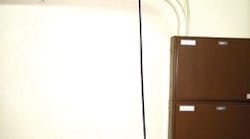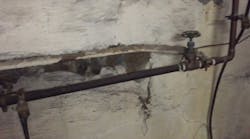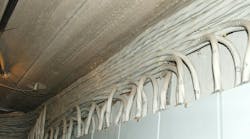As usual, never consider the following commentary associated with these photos as a formal interpretation of the National Electrical Code (NEC). Without criticizing anyone or any product, the following scenarios present us with serious safety questions.
All references are based on the 2005 NEC.
STRETCHED A BIT TOO FAR
“Ironically, the U.S. government contractor who maintained this building stated that an emergency light was required to comply with the NEC,” says Eric G. Lemmon, principal engineer, ULA Delta II Facilities Engineering, Denver. “I have found dozens of retrofitted emergency light units installed with EMT to surface extension boxes at wall receptacle locations. It seems that not every installer has read the requirements of 700.12(F).”
I couldn't agree with you more, Eric. As per a portion of 700.12(F), “Unit equipment shall be permanently fixed in place (i.e., not portable) and shall have all wiring to each unit installed in accordance with the requirements of any of the wiring methods in Chapter 3. Flexible cord-and-plug connection shall be permitted, provided that the cord does not exceed 900 millimeters (3 feet) in length. The branch circuit feeding the unit equipment shall be the same branch circuit as that serving the normal lighting in the area and connected ahead of any local switches. The branch circuit that feeds unit equipment shall be clearly identified at the distribution panel. Emergency luminaires (illumination fixtures) that obtain power from a unit equipment and are not part of the unit equipment shall be wired to the unit equipment as required by 700.9 and by one of the wiring methods of Chapter 3.”
MISSING IN THE MIDDLE
“We took over a new housing site on the beach,“ says Marc VanOstrand, owner of Grays Harbor Star Electric in Aberdeen, Wash. “My electrician went to hook up a new hot tub and found this. These are high-end homes.”
As you can see, this raceway is non-continuous and lacks proper fittings and terminations to the equipment. This installation violates some of the requirements in Art. 352 (Rigid Nonmetallic Conduit: Type RNC), Part II. More specifically, 352.10 states, “The use of RNC shall be permitted in accordance with 352.10(A) through (H).”
In addition, it also violates the requirements of 352.30, which states “RNC shall be installed as a complete system as provided in 300.18 and shall be fastened so that movement from thermal expansion or contraction is permitted. RNC shall be securely fastened and supported in accordance with 352.30(A) and (B).” We can also cite a violation of 110.12, Mechanical Execution of Work.
Found a Code Violation? E-mail your photos (no cell phone images please) to Joe Tedesco at [email protected]






